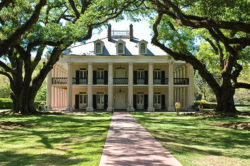Oak Alley Plantation
The 800-foot-long allée of live oak trees leading from the river to the columned house constitutes one of the most familiar and evocative images of Louisiana's grand plantation houses.

Courtesy of Flickr
Oak Alley Plantation. McCarthy, Michael (Photographer)
The eight-hundred-foot-long allée of twenty-eight massive, ancient live oak trees leading from the Mississippi River to the columned house of Oak Alley Plantation constitutes one of the most familiar and evocative images of Louisiana’s grand plantation houses. The plantation is located on the west bank of the river in St. James Parish, upriver from Vacherie.
The oaks were planted between 1725 and 1750 by a settler, almost a century before Jacques Télésphore Roman (brother of Governor André Roman) and his wife, Marie Thérèse Celina Pilié Roman, acquired the plantation. The Romans’ new house, which they named Bon Séjour, was built by George Swainey, although Samuel Wilson attributed its design to architect Joseph Pilié, Marie Thérèse’s father. Oak Alley is square in plan and constructed of brick, stuccoed, and colored pale peach. Measuring seventy feet on each side, the house is surrounded by a gallery supported on twenty-eight colossal Tuscan columns, the same number as the oak trees. The hipped roof has three gabled dormers with round-headed windows on each side, which were added in the twentieth-century restoration undertaken by architect Richard Koch.
Compared with the grand exterior, the interior is surprisingly low-key. The rooms are large but not ostentatious, and the plan is quite simple, with a central hall on both floors. Doors at each end of the halls have elliptical fanlights and narrow side lights framed with delicate, fluted colonnettes.
No buildings survived to tell about the lives of the enslaved workers on this nine-thousand-acre plantation, although records indicate that they were housed in twenty-four cabins. Other buildings included a hospital, an overseer’s house, stables with one hundred stalls, a sugarhouse, and a sawmill. In 1846 an enslaved man named Antoine successfully grafted pecan trees to create the first named variety, Paper Shell, which was then grown in the first commercial pecan orchard at nearby Anita Plantation.
Oak Alley had several owners after the Romans; in 1925 Andrew Stewart bought the property as a gift for his wife, Josephine, and the house was restored by architect Richard Koch. Before she died in 1972, Josephine Stewart created a foundation to preserve the house and open it to the public. The house was listed in the National Register of Historic Places in 1978 and functions as a museum and inn. In 2013, after conducting archeological research, the Oak Alley Foundation constructed several cabins in the footprint of the original houses for the enslaved workers. These cabins contain exhibits on the daily lives of the people—nearly two hundred individuals—who built the plantation and served the owners.
The grounds also include a working blacksmith shop constructed around the remains of the original forge and a Civil War encampment, where reenactors explain how the plantation was affected by the war’s strife. Oak Alley’s house and iconic double row of trees have appeared in many commercials and several feature films, most notably The Long, Hot Summer (1957) and Interview with the Vampire (1994)
Adapted from Karen Kingsley’s Buildings of Louisiana, part of the Buildings of the United States series commissioned by the Society of Architectural Historians (www.sah.org) and published by Oxford University Press.
